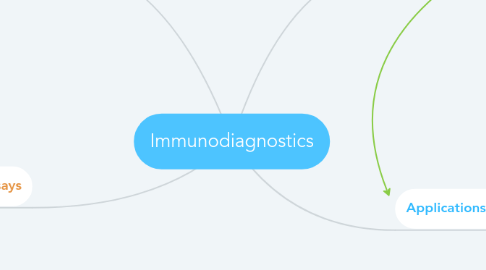
1. ELISA
1.1. Indirect ELISA
1.2. Sandwich ELISA
1.2.1. Can be both quantitative and qualitative
1.3. ELISPOT Assay
1.3.1. Based on ELISA, but allows quantification of cytokine producing cells
2. Cell based immunoassays
2.1. Cell isolation
2.1.1. WBC seperated from peripheral blood using density centrifugation
2.1.1.1. Ab and magnets can be more specific and isolate a certain type of cell
2.2. Quantification of cells
2.2.1. Using hemocytometer
2.2.1.1. Identifies T cells and B cells via flow cytometer
2.2.1.2. Uses peptide/MHC to identify antigen specific T cells
2.3. Cell proliferation
2.3.1. MTT assay- Enzymatic approach
2.3.2. Radioactive approach- H-Thymidine incorporation
2.3.3. Fluorescent approach- Labelling protein of cells with fluorescent dye
2.4. Cell death assay
2.4.1. When cells die they lose integrity allowing vital dye to enter cells and stain
2.4.1.1. Trypan blue
2.5. Cell function assay
2.5.1. ELISPOT, ELISA
3. Monoclonal Ab
3.1. Produced in large quantities
3.2. Bind specific epitope of antigen
3.3. Can be highly purified
3.4. Allows for in depth analysis
4. Applications for Abs
4.1. Some assays use antibody without further development
4.1.1. Ouchterlony test
4.2. Often requires conjugation of enzyme or fluorochrome to allow detection of the antibody
4.2.1. Fluorescence
4.2.1.1. Read via a flow cytometer
4.2.1.1.1. Forward scatter
4.2.1.1.2. Side scatter
4.2.1.2. Fluorescent microscopy
4.2.1.2.1. Proportion of CD4+ cells
4.2.1.2.2. Amount of cytokine being produced
4.2.1.2.3. Upregulation of surface receptor
4.2.2. Commonly used fluorochromes are GFP FITC and PE

